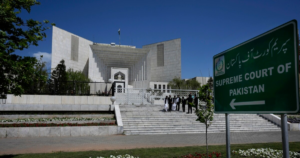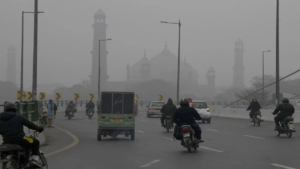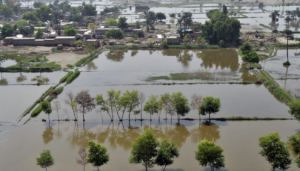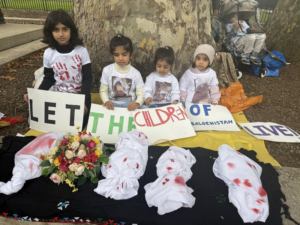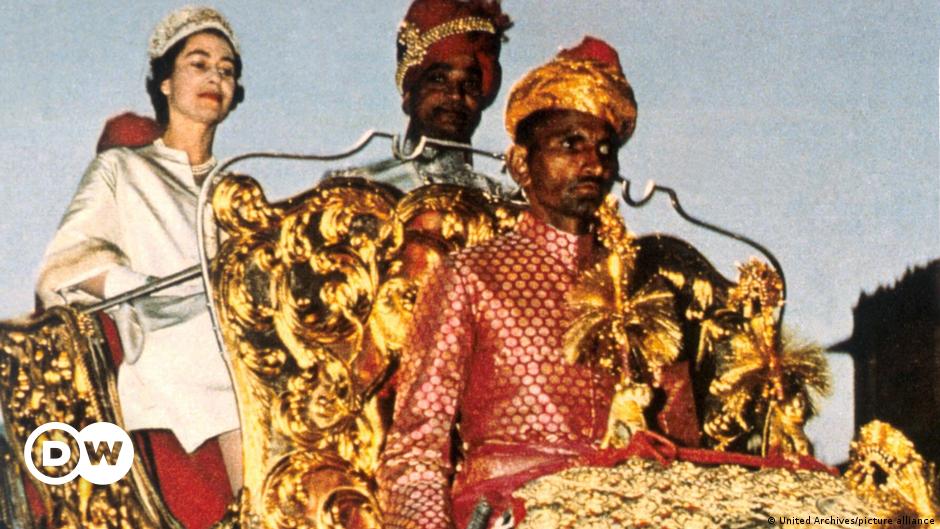
Elizabeth II was crowned queen of the United Kingdom in 1952, just five years after India and Pakistan gained independence from British colonial rule. The memories of British rule, which was marked by the subjugation of the people of then-undivided India, were fresh in public memory at the time.
Just 25 years old when she became queen, Elizabeth, however, is largely admired and respected by people in the former British colonies.
People in India and Pakistan — as well in other South Asian countries, such as Bangladesh, Nepal and Bhutan — received the news of the queen’s death with a great deal of sadness. Thousands of South Asians posted condolences on social media.
“The role of Queen Elizabeth II between 1952 and 1956 was passive and uneventful. She deliberately kept herself away from interfering in Pakistan’s internal matters,” Mazhar Abbas, a historian at Government College University Faisalabad, told DW.
“She engaged with India and Pakistan through the Commonwealth platform,” he added.
Elizabeth also remained neutral in conflicts between India and Pakistan.
“In fact, Indian politicians appreciated her stabilizing role in British politics” after she took over as head of state of the United Kingdom, according to Indian historian Rakesh Batabyal.
Britain mourns the passing of Queen Elizabeth II
Respect for Elizabeth II
“While history has documented the servitude during the colonial era, our relationship with the British monarchy has remained cordial after gaining independence. The queen visited Pakistan many times and maintained good relations with our leaders,” Shazia Marri, Pakistan’s poverty alleviation minister, told DW.
Asif Nazrul, a professor at Dhaka University in Bangladesh, expressed similar sentiments. “ln spite of the colonial legacy, many people in Bangladesh are sad. We can’t live in the past forever. Queen Elizabeth’s calm, soothing and accommodating image eventually prevailed in the last few decades,” he said, adding that the world has lost an “icon of history.”
Subhash Talekar, president of the Mumbai Dabbawala Association, a food delivery service, said he was saddened by the queen’s death.
“We have a great association with the British royal family. Ever since Price Charles [now King Charles III] visited Mumbai in 2004, the connection has grown,” Talekar told DW. “The royal family invited two of our colleagues to the wedding ceremony of Charles and Camilla Parker in 2005. The invitation from the queen had a personal touch, which reflected her human side,” Talekar said.
Elizabeth II met with former Pakistani Prime Minister Benazir Bhutto in 1997
A difficult relationship nonetheless
But not everyone is ready to gloss over Britain’s colonial rule. Some have even criticized Elizabeth’s “noninterference” approach, for instance, during the first four years of Elizabeth’s rule when she was also the “Queen of Pakistan.” The monarchy was abolished on March 23, 1956, when Pakistan became a republic within the Commonwealth with a president as its own head of state.
“She never used the Commonwealth platform to resolve the Kashmir dispute between India and Pakistan,” said Abbas, the Pakistani historian.
“She could have played a role in strengthening parliamentary democracy in Pakistan. For instance, she could have interfered in 1953, when Ghulam Muhammad, the then governor-general of Pakistan, dismissed the then prime minister, Khawaja Nazimuddin. The deposed PM made a futile attempt to request the queen to reverse Muhammad’s decision,” he added.
But Nonica Datta, a historian at the Jawaharlal Nehru University in Delhi, told DW that Elizabeth had inherited “an enduring and complex legacy of the British empire.”
“She represents the end of the British Empire and the transition of former colonies into independent states. Rarely do we find such a historical figure who embodied the spirit of colonial and imperial past laced with the post-World War II democratic values of the new world order,” Datta said.
Elizabeth met with Indian Prime Minister Narendra Modi at the 2018 Commonwealth Heads of Government Meeting
Vijayasai Reddy, an Indian lawmaker, tweeted that Queen Elizabeth II “may not have apologized for India’s brutal colonization… but her leadership qualities and morality impacted UK politics.”
Anti-colonial sentiment
Shahidul K K Shuvra, a Bangladeshi journalist, told DW he was befuddled as to why people on the Indian subcontinent are so anguished by Elizabeth’s demise.
“South Asians are always more interested in the queen and the royal family rather than how Britain exploited them for 200 years,” he said. “The precious Koh-i-Noor [one of the largest cut diamonds in the world] on her crown was taken away from India,” he added.
Saimum Parvez, a political analyst in Dhaka, also played down the significance of the queen’s death for the people in South Asia.
“The death of the queen does not have any impact on our lives, neither socially nor politically. The Bangladesh government has announced a three-day national mourning, which was expected, but is totally unnecessary,” he said.
“Yes, we don’t want to live in the colonial past,” he added, “but we should not also completely forget what we went through under this monarchy.”
Indian writer Rana Safvi, however, said condoling the death of Queen Elizabeth II was not synonymous with condoning or forgetting colonialism. “We, in India, are still suffering because of the colonial policies,” Safvi said. “We don’t have to endorse the monarchy.”
Elizabeth II: The life of a queen Mourning Elizabeth II “Grief is the price we pay for love,” Queen Elizabeth II once said. Now the world mourns her — the Queen of Great Britain and Northern Ireland died on Thursday after 70 years as sovereign. The queen saw the disintegration of the British Empire, appointed 15 prime ministers and weathered turbulent times in her family.
Elizabeth II: The life of a queen Queen at 25 George VI, King of the United Kingdom died on February 6, 1952. His 25-year-old daughter Elizabeth was traveling at the time and received the news in Kenya. She did not have time for silent mourning — now Elizabeth was the Queen. She was crowned almost a year and a half later, in June 1953 in London’s Westminster Abbey, the Church of the Kings
Elizabeth II: The life of a queen Preparation for her future role Elizabeth Alexandra Mary was born in London on April 21, 1926, the first child of the Duke and Duchess of York. Her father George VI ascended the British throne in 1936, making his eldest daughter heir to the throne. Over the years, she was systematically prepared for her future role. During World war II, Elizabeth gave her first speech broadcast by the BBC. She was 14 at the time.
Elizabeth II: The life of a queen Queen and mother In November 1947, Elizabeth married Prince Philip of Greece, who was five years her senior and of German descent. Charles was born the next year, followed two years later by the couple’s first daughter, Anne. In all, Elizabeth had four children: Andrew was born in 1960, and Edward in 1964.
Elizabeth II: The life of a queen Queen and mother In November 1947, Elizabeth married Prince Philip of Greece, who was five years her senior and of German descent. Charles was born the next year, followed two years later by the couple’s first daughter, Anne. In all, Elizabeth had four children: Andrew was born in 1960, and Edward in 1964.
Elizabeth II: The life of a queen Queen of people’s hearts? Every year, she celebrated the traditional Trooping the Colour military parade, an event marking the official birthday of the British sovereign since 1748. This year was her Platinum Jubilee, marking 70 years of service to the people. She was respected and revered, popular and well-liked. But Queen of Hearts she was not; that was a nickname later given to another member of the royal family.
Elizabeth II: The life of a queen Difficult years For many people in Britain, Lady Diana, the late wife of then-Prince Charles, and the monarch’s daughter-in-law, was the Queen of Hearts. The marriage fell apart, the heir to the throne and Lady Diana were divorced in 1995. When Lady Diana died in a car accident two years later, the Queen’s rather cool reaction provoked fierce public criticism.
Elizabeth II: The life of a queen The next fairytale wedding Diana’s eldest son, Prince William, married Kate Middleton in April 2011, and millions of people celebrated the bride and groom. Reportedly, the Queen gave Kate a few tips before the engagement, and her granddaughter-in-law quickly grew into her royal role, delighting the Queen with a happy marriage and three great-grandchildren.
Elizabeth II: The life of a queen Renegade grandson Diana’s younger son, Prince Harry, married the US actress Meghan Markle in 2018, and the Queen gave her blessing. However, royal life did not suit the young couple. In an interview with Oprah Winfrey, both spoke openly about their difficulties with the institution of monarchy. The couple ultimately said goodbye to royal life and moved to the US.
Elizabeth II: The life of a queen Life in the spotlight The crown can be a burden as it comes with great responsibility and a life under permanent public scrutiny. Family problems, divorces, deaths, scandals — Elizabeth coped in her own calm way. That’s what most people in Britain liked about her.
Elizabeth II: The life of a queen Monarch for 15 Commonwealth realms She appointed 11 men and three women prime minister of the UK, the latest being Liz Truss in September 2022. As head of a constitutional monarchy, in addition to the UK, Elizabeth had a symbolic function in the 14 Commonwealth realms, which includes Australia, Canada, Jamaica and New Zealand.
Elizabeth II: The life of a queen Many dignified decades In 1952, Elizabeth said her coronation should not be a sign of power and past greatness, but rather an expression of hope for the years she would be allowed to serve and rule with God’s grace. Decades later, she was the longest-serving head of state in the world.
Elizabeth II: The life of a queen ‘Defender of the faith’ and style icon Her full title was Elizabeth the Second, by the Grace of God Queen of the United Kingdom of Great Britain and Northern Ireland and her other countries and territories, Head of the Commonwealth, Defender of the Faith. She was also known for her monochrome skirt suits and elaborate, matching hats.
Elizabeth II: The life of a queen Deep sorrow In April 2021, Queen Elizabeth’s husband, Prince Philip, died two months before his 100th birthday. They were married for 73 years and navigated all manner of crises, including marital crises. But even the loss of her husband and companion did not keep the Queen from her duty and she continued to serve as head of state.
Elizabeth II: The life of a queen Farewell, my Queen The world bids farewell to Elizabeth II, Queen of the United Kingdom for almost seven decades, mother of four children, one of the defining figures of the 20th century and the present. The throne of the rulers of England will now be taken by her son, King Charles III. Author: Sabine Peschel
Additional reporting by Murali Krishnan (New Delhi), Haroon Janjua (Islamabad) and Arafatul Islam (Bonn).
Edited by: Srinivas Mazumdaru





